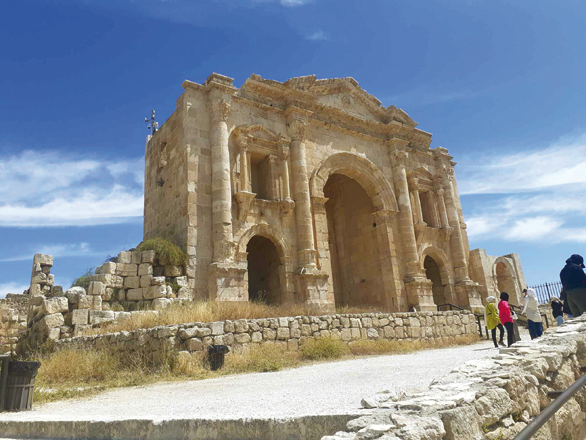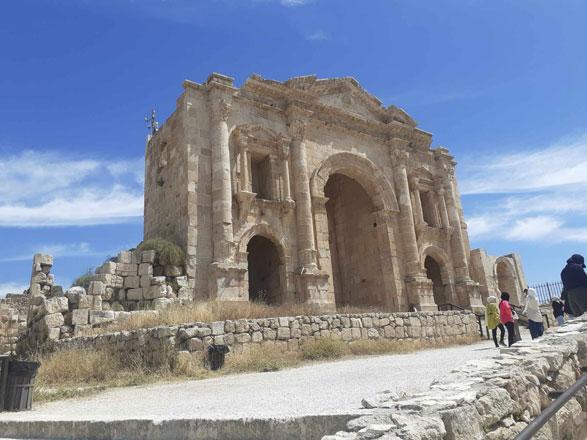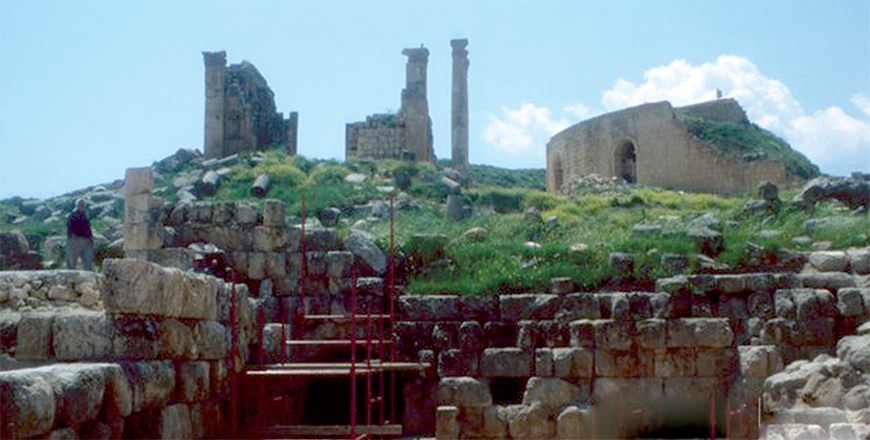You are here
Archaeological findings at Gerasa’s hippodrome shed light on Roman occupation
By Saeb Rawashdeh - Nov 20,2024 - Last updated at Nov 20,2024

The Hadrin Arch in Gerasa, built in the 2nd century AD to commemorate a visit of the Roman Emperor Hadrian in 129/130 AD (Photo by Saeb Rawashdeh)
AMMAN — The major renovation of Gerasa (modern Jerash) took place in the first half of the 2nd century AD when the Roman Emperor Hadrian visited the city. The city was part of the Seleucid league of Hellenistic cities from the 2nd century BC, and when Hadrian arrived, the necropolis and quarry were permanently shot down. The plan was to upgrade Gerasa and new cadastral zones were drawn up to embellish the prosperous but still relatively modest provincial town.
"Ambitious building projects were to bring about Hadrian’s vision of Roman Gerasa, indeed encompassing most of what we know and still see today. Knowing of Hadrian’s ambitions in the arts, work may have begun under his direct tutelage during his stay in 129 / 130 AD, certainly shortly after," Ina Kehrberg-Ostrasz, a professor from The University of Sydney, said.
He added that the building programme included the city wall and expanding secular and religious precincts on previous cemetery grounds in the southern and northern areas and beyond the city gates.
The hippodrome site was probably the most important extramural zone as it comprised the Roman road approaching Gerasa from Philadelphia: it was here that Hadrian’s Arch was built, followed shortly after by the hippodrome or Roman circus by about the middle of the 2nd century AD.
Trenches of the closed quarry and sealed hypogean tombs formed some of the foundations for the new Roman town, as evidenced in particular at the hippodrome, Kehrberg-Ostrasz continued, adding that except for being part of the south-east cavea and carceres foundation, these earliest rock-cut tombs at the hippodrome site do not concern the circus as such, its builders or subsequent occupants.
The archaeological team worked from 1991 to 1993 because the fragile skeletons of well over 200 bodies could only be excavated during the dry season.
"The skeletal remains were kept in their separate lots according to excavated loci in order to correlate them with the excavation sequence and other finds from the same loci or lots. They were subsequently examined in storage by osteo-archaeologists," Kehrberg-Ostrasz underlined.
While the schematic plans at provide an overview of the excavation history of the hippodrome, the hippodrome ground plan at marks the locations of burials belonging to secondary occupancies or the industrial phase of the circus building and periphery, the professor elaborated, adding that the burials, or rather the graves and their contents - deliberate offerings or part of the ground into which the graves were placed - are presented in chronological order approximating the dates of interment.
These simple burials were placed in the cavea chambers of the hippodrome or were buried in the grounds outside it, but never in the arena. Most of the graves in the chambers were superimposed by debris of later occupancies, usually workshop dumps that at times contaminated the upper layer covering the tomb, a situation exacerbated by earthquake tumbles," Kehrberg-Ostrasz said, noting that this, as well as the practice of digging a pit and covering the burial with the dug-up dirt, made precise dating of burials without grave goods more difficult.
“However, one can safely posit that the simple graves belong to the second or industrial phase of occupancy at the hippodrome encompassing the later 3rd to the late 6th / early 7th centuries AD, or Late Roman to Late Byzantine periods, excepting the two mass graves of the mid-7th century plague victims interred there after an interval of abandonment,” Kehrberg-Ostrasz underscored.
Related Articles
AMMAN — Ancient Gerasa (modern Jerash) was a well-known centre for pottery production: The evidence for that large scale commerce comes from
AMMAN — In the 1st century BC and 1st century AD, Gerasa (modern Jerash) had operational quarries, which are types of open-pit mines used fo
AMMAN — When the Roman Emperor Hadrian visited Gerasa (ancient Jerash) in 129/130 AD, the Roman Empire was at its peak.

















